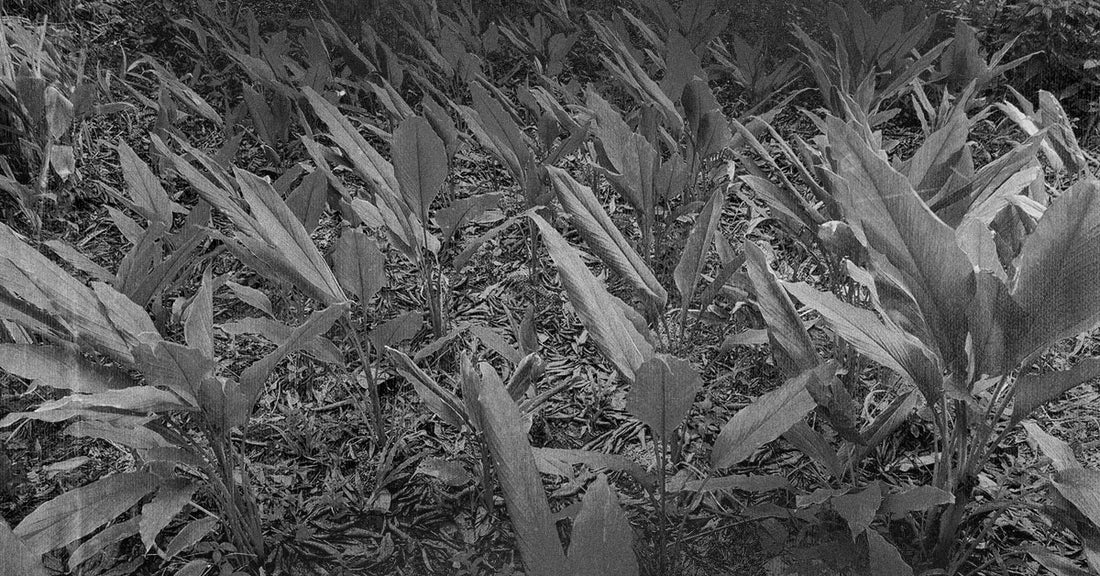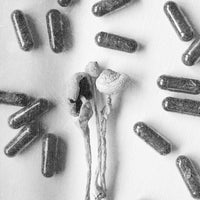Editor's Note: In honor of the golden gift from the heavens that is turmeric, MUD/WTR would like to announce our new :balance Turmeric blend. With zero caffeine, our blend of turmeric, spices and mushrooms gives you focus, immune support and—most importantly—balance. It'll support you throughout the day, without messin' with the night. Enjoy reading about the history of this beloved root, below.
While my thaththa (father) had many post-retirement plans, he mostly devoted his time growing kaha—Sinhala for turmeric—in our back garden in Kurunegala, about 120 km north of Colombo. The process would begin with tilling the soil in the backyard dotted with banana trees. Beneath these trees that filter the harsh rays of the scorching Sri Lankan sun, thaththa raised ridges and planted turmeric rhizomes. When the plants slowly began to yellow after about eight months, thaththa uprooted them with care, only extracting the fattened rhizomes, boiling, sunning and grinding them for turmeric powder.
Unlike store-bought turmeric we previously used, my thaththa’s homegrown turmeric dust carried a wonderful earthy scent: woody, gingery and orangey. “Add only a bit of it when you cook,” thaththa would say while shuttling me tiny, meticulously-packed pouches of turmeric during his visits to Colombo.
Turmeric is both an everyday culinary spice and a medicinal herb in Sri Lankan homes. Yet, only about 2,000 metric tons of turmeric is locally grown (the country as a whole uses 6,000 metric tons a year). Recently, when the Sri Lankan government enforced import bans, controlling turmeric shipped from India to Sri Lanka, many households ran out of the spice. While others hastily emptied supermarket shelves and peered through assorted grocery shops, my family had the luxury to pack turmeric in several tightly-sealed glass jars thanks to my thaththa’s backyard turmeric farm.
 Fresh turmeric drying in the heat of the Sri Lankan sun
Fresh turmeric drying in the heat of the Sri Lankan sun
Turmeric Holds Religious and Cultural Significance in Hindu Households
Boasting of culinary, religious, and medicinal uses, the history of turmeric dates back to the Vedic culture influenced by ancient Hindu texts. About 4,000 years ago, Atharvaveda, a sacred Hindu scripture written about knowledge and procedures for everyday life, mentions that turmeric prevented jaundice.
In Sri Lanka, turmeric is a symbol of purity and sacredness. Hailed for its antioxidant, anti-inflammatory and antimicrobial properties, people often use turmeric as a natural cleanser. In the wee hours of the morning, hole-in-the-walls, grocery shops, and electronic and fabric stalls that line the streets in Colombo’s Hindu neighborhoods mop their floors with turmeric-infused water. Every morning before faithful worshippers make their way to Hindu temples—kovils as they are known—scrub their floors with turmeric water.
Hindu culture values turmeric as auspicious. On the wedding day, the groom ties a string dyed yellow with turmeric over the bride’s neck—a ritual often compared to exchanging rings in Western ceremonies. In Hindu households, mothers draw several lines at the front door with turmeric, a domestic practice that keeps away insects and wards off evil spirits.
Turmeric is a Medicinal Herb
While the Ayurveda medicine system hailing from India is prevalent in Sri Lanka, the country is also home to a myriad of native healing practices, including ath beheth that incorporates cures for everyday minor ailments. “A very common example of ath beheth is gargling with salt and turmeric water when we have a sore throat,” says Premathilaka Satharasinghe, an ayurveda practitioner and traditional healer. I can resonate. Whenever I suffered from a sore throat as a child, my father would pour me a glass of lukewarm salt water mixed with turmeric powder, before a visit to the doctor.
Satharasinghe explains that native folk medicine celebrates turmeric for its disease-fighting qualities. A thick paste of turmeric, he says, often helps heal wounds and cuts, while also reducing scarring. “It’s also a reason why many young women apply a turmeric paste mixed with other herbs like sandalwood on their skin. It’s a remedy for acne scars and blemishes,” he says. For headaches, a tightly assembled pouch of herbs like fresh turmeric (crushed rhizomes before sun drying), neem leaves and finely-sliced red onions are steamed and repeatedly pressed on the forehead.
“Manjal (Tamil for turmeric) contains the active ingredient curcumin, which boasts of antioxidant activity and can improve our health by increasing immunity. We consider it a kayakakatpa mooligai or a rejuvenating herb,” says Vindya Alawala, a student of Siddha medicine at the Eastern University in Sri Lanka. One of the oldest healing systems originating in South India, Siddha medicine is practiced in Tamil and the Muslim-populated Eastern and Northern provinces in Sri Lanka. Alawala explains that turmeric is a widely-used medicinal plant in the Siddha system. Mothers, for example, use turmeric before and after giving birth. “Pregnant mothers drink turmeric-infused milk to enhance the complexion of the baby. Because of its analgesic property, we use turmeric to reduce labor pains. After birth, mothers drink turmeric powder mixed with honey and ghee. Turmeric acts as an antiseptic and arrests bleeding,” says Alawala.
Turmeric Enhances Sri Lankan Cuisine
Despite its significance in religious and medicinal spheres, it’s often inside a Sri Lankan kitchen that turmeric truly comes to life. “Turmeric is the main coloring agent in our cooking,” says Chamara Kothalawala, sous-chef at the Colombo restaurant Upali’s by Nawaloka. Kothalawala refers to the country's dal dishes colored bright yellow. My father makes kiri hodi, a coconut milk gravy, and dyes it with rich turmeric to eat with toast.
Turmeric alone carries a robust, earthy flavor with mild peppery notes. High quantities can be bitter. “When you dust your curries with turmeric and other spices like red chili powder, coriander, cumin, nutmeg and cinnamon, turmeric helps blend flavors well. But if you leave it out, only an engrossed epicurean can really tell the difference,” says Kothalawala.
Color and flavor aside, Kothalawala says Sri Lankans use turmeric in food mainly for another reason. “Cleansing,” he says. “We believe turmeric helps kill the germs in our food. So we add it to our fish, chicken and other meat-based curries. Before cooking, I wash meat and fish in turmeric water because it helps leave all the harmful things.”
But Kothalawala believes most home cooks use turmeric out of habit and not necessarily because they are thoughtful about its disinfecting traits. “Adding turmeric to our curries, gravies and sambals is a practice passed down from our ancestors. It’s so deeply etched in us that it’s become habitual—the Sri Lankan kitchen is not the same without turmeric.”
“Trust me, this is coming from a chef—food should always look good because you first eat with your eyes. And it’s turmeric that always brightens and enriches our food.”
Turmeric Goes Global
Over the last decade, turmeric has become a popular superfood in the West. In 2017, Starbucks introduced the Golden Turmeric Latte—turmeric powder mixed with milk and poured over an espresso. Popular as the “golden milk,” The Guardian reports that turmeric milk has a “cult following” across the world. “But in South Asian cultures, turmeric milk—commonly known as haldi doodh by Hindi speakers in India—acts as a soothing agent for the throat. For centuries, It has been used to treat coughs, colds and insomnia and purify the blood,” says Alawala.
From Vedic cultures in India 4,000 years ago to a latte in Starbucks, turmeric has had a long and colorful journey, shaped by the varied influences of migration, travel and cosmopolitan societies. Despite the global evolution of turmeric, Sri Lankans continue to hold this bright-hued spice near and dear to our lives. An everyday spice that cures ailments, cleanses our homes, enriches our food and as we have believed for centuries, brings us charm, turmeric is truly the star ingredient of Sri Lankan kitchens.
And like my thaththa says, “It’s the golden spice more valuable than gold itself.”
Zinara Rathnayake is an independent journalist based in Colombo, Sri Lanka and Guwahati, India. You can find her on Twitter.
Read more: The History and Origins of Ashwagandha
Read more: The History and Origins of Masala Chai
Read more: Mumbai's Chai of Choice




